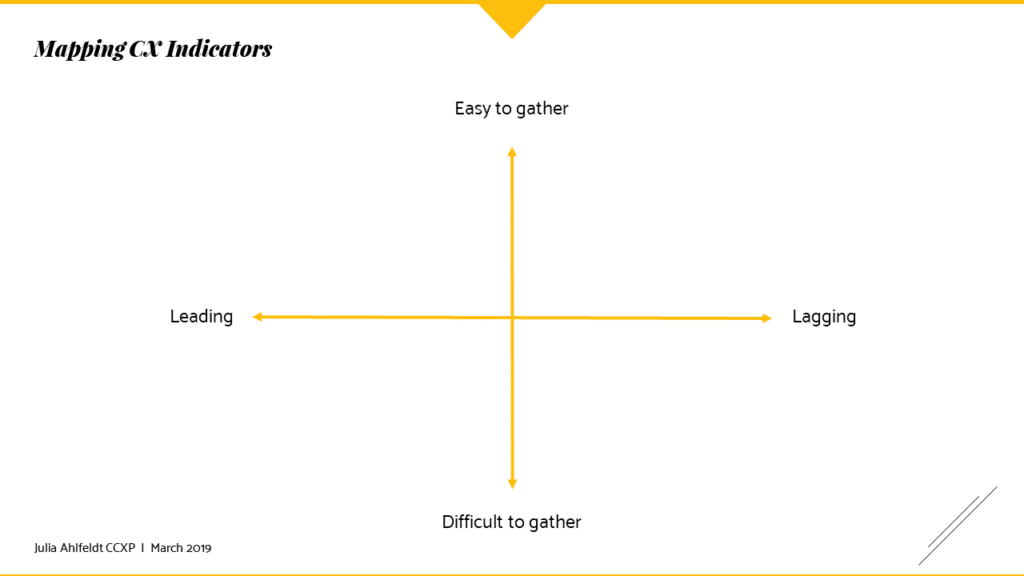Podcast: Play in new window | Download (7.9MB)
Subscribe: Apple Podcasts | TuneIn | RSS | More
This CX Mini Masterclass explains the role of leading and lagging indicators in measuring customer experience. Show host and customer experience expert, Julia Ahlfeldt, shares examples for how you can build a balanced view of customer experience with the right mix of CX metrics and measures. If you are wondering how to move beyond a one-metric view of CX, this episode is for you.
How to Measure Customer Experience Holistically: A Balanced Approach
When organizations begin monitoring and evaluating customer experience, there is a natural tendency to latch onto one number. Often this number is one of the 3 most popular mainstream CX metrics: CSAT, NPS or CES. These metrics are useful, but they have their limitations, and it’s unrealistic to assume that you can understand the full picture of CX through just these number s alone.
Organizations should track and evaluate their CX performance through a number of metrics and measures that can be brought together to create a more comprehensive view. I recommend creating this holistic view through a combination of leading and lagging indicators.
What Are Leading and Lagging Indicators in Customer Experience?
So what are leading and lagging indicators?
- Understanding Leading indicators in CX
- What are they: measures that precede or feed into a customer experience. These should indicate whether or not an experience will be successful. If we think of customer experience like baking a cake, these would be your inputs or ingredients.
- Examples: wait time, processing time, product availability, system downtime, product quality – these are all things that might contribute to customer experience
- How can they be used to manage CX: leading indicators help predict the outcomes of experiences and many of them can be measured and monitored before experiences even happen. These can be used to proactively intervene when experiences start going sideways. Additionally, these measures can be leveraged to set department or individual KPIs for teams that operationally contribute to experiences.
- Understanding Lagging indicators in CX
- What are they: metrics or measures that happen after a customer experience. These should indicate whether or not an experience was successful. These indicators would tell us whether or not the cake was delicious and possibly how that impacted our relationship with the person we fed it to.
- Examples: customer satisfaction (CSAT), net promoter score (NPS), customer effort score (CES), first contact resolution, customer retention, average spend – these are all things that might come out of or be affected by a specific customer experience
- How can they be used to manage CX: lagging indicators help us understand “how we did”. The experience happened and is in the past, but we can use these indicators to evaluate the result and the impact. Lagging indicators are important for monitoring progress (i.e. over time you would want these metrics to improve), and for tracking the impact of customer experience efforts. Lagging indicators such as retention and spend can be especially helpful for tying CX back to business value.

Measuring customer experience impact and CX ROI
If you want your CX leading and lagging indicators to really resonate with business leaders, consider linking these to business impact. Believe it or not, your existing indicators can be used to calculate CX ROI. For more on this, including examples and guidance on how to measure the business impact of CX, be sure to check out my Ultimate Guide to the ROI of Customer Experience.
Linking Customer Experience Metrics to Business Impact and ROI: Quick FAQ for Leaders
- What is the best way to measure CX performance? Start by identifying the inputs for your customer journey analytics. These will be unique to each situation, but should ideally include a mix of leading and lagging indicators. Next, clarify your desired customer outcomes through customer satisfaction benchmarking. Identify metrics or measures that indicate the success or failure of customer journeys in terms of customer outcomes (these are your lagging indicators). Then map the processes that contribute to customer outcomes, and identify the measures that track whether or not these processes are working. (these are your leading indicators).
- How do CX metrics connect to financial performance? Customer outcomes can often be linked to customer actions that impact the business bottom line. E.g. Customers who experience a seamless onboarding process are more likely to repurchase. Additionally, leading metrics such as error rates, drop offs, etc., may also have efficiency implications. Assess your leading and lagging indicators through the lens of “how does this eventually impact the business”.
- Which CX indicators are most predictive of business success? The magic question! In my experience with CX ROI tracking, I’ve found that propensity to repurchase, as well as Customer Lifetime Value (CLV) are highly predictive of business success.
Want to keep learning about CX?
If you’d like to checkout more of these CX Mini Masterclasses or listen to my longer format CX expert interviews, check out the full listing of episodes for this CX podcast.
Decoding the Customer is a series of customer experience podcasts created and produced by Julia Ahlfeldt, CCXP. Julia is a customer experience strategist, speaker and business advisor. She is a Certified Customer Experience Professional and one of the top experts in customer experience management. To find out more about how Julia can help your business achieve its CX goals, check out her customer experience consulting services (including journey mapping, CX strategy development, experience innovation, leadership workshops and CX ROI measurement) or get in touch via email.